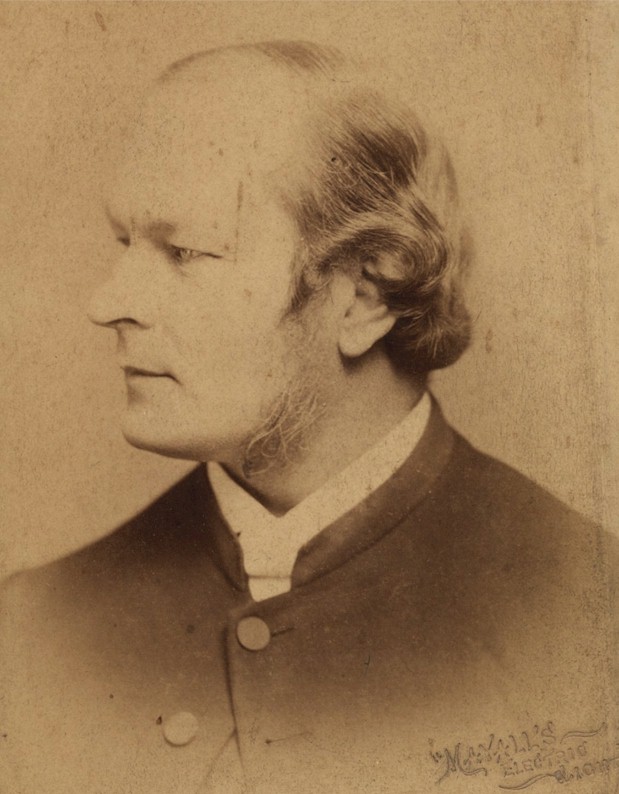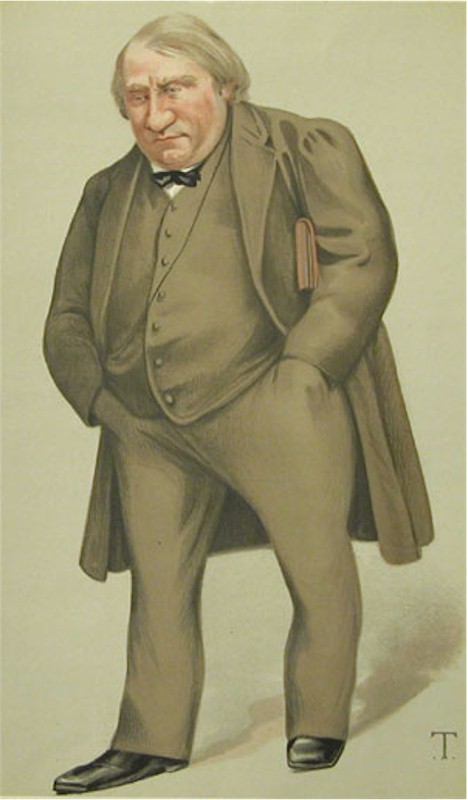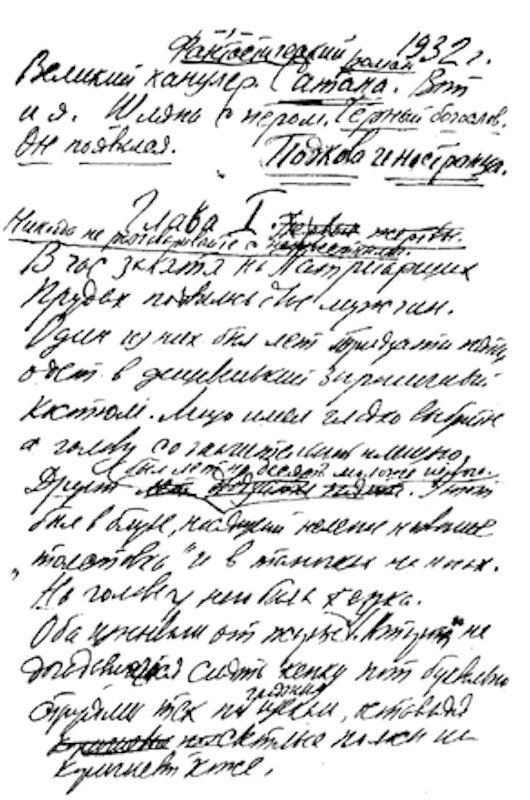Genesis of the novel
English > The novel > Genesis of the novel
Introduction
Mikhail Afanasievich Bulgakov (1891-1940) began writing The Master and Margarita at the end of 1928, or in the beginning of 1929. This can be deduced from the fact that he presented the text of Мания фурибунда [Maniya furibunda] or Raging Madness on May 8, 1929 under the pseudonym K. Tugay to the publishing house Nedra. It was the fourth chapter of The Engineer's Hoof, the second version of the novel that would later become known under the title The Master and Margarita. The publishing house refused to publish the text.
1929 was the year when Bulgakov's theatre plays were removed one after the other from the scenes and he himself became the target of a press campaign aimed at ruining him as a writer. The representations of The Days of the Turbins at the Moscow Art Theater MKhAT were halted. That play was a theatre adaptation of Bulgakov's novel The White Guard, and has been performed with great success since October 5, 1926. Despite the fact that Joseph Vissarionovich Stalin (1878-1953) seemed to love this piece, it was removed on February 26, 1929. In that respect nothing fundamentally changed in the years that followed, as none of his books were published and, with the exception of his adaptation of Dead Souls and some representations of Molière, his plays did not make it to the stage.
The Master and Margarita was thus written in a very dark political context, a hopeless situation on a professional and human level. When the author continued to work sporadically on the book in 1931, he wrote «1929-1931» on the cover, but in The Prince of Darkness, the sixth version of the novel from 1937, he wrote «1928-1937».
He would continue to work on it even until a few weeks before his death in 1940. Thus, The Master and Margarita would accompany him through the most difficult years of his life.
The archives of Mikhail Bulgakov have remained inaccessible for a long time. Moreover, Bulgakov kept some of his rough drafts, but destroyed others. The first two versions of the novel are known to us from two notebooks that were partially torn. Philologist Marietta Omarovna Chudakova (°1937) was the first Russian researcher to attempt to reconstruct these first texts in 1977. But the book's history took twelve years, it had at least six different versions, sometimes very complex, and sometimes opposed to each other. They show many interruptions and far-reaching revisions.
And sometimes new discoveries are mde. An example of this is the diary that Bulgakov kept between 1921 and 1925. It was confiscated in 1926, and did not surface until much later. The typewritten copies were not published until 1990. It is therefore possible that sources may emerge which may provide a surprising new perspective on the novel and its developments.
A novel about the devil
In the book My Life with Mikhail Bulgakov, which was written in 1968-1969 by Lyubov Yevgenyeva Belozerskaya (1894-1987), Bulgakov's second wife, we can read that Bulgakov got the idea of writing a novel about the devil in Moscow from Natalia Abramovna Lyamina-Ushakova (1899-1990), the wife of his best friend Nikolay Nikolaevich Lyamin (1892-1941).
Natalia had designed the cover of the book Venediktov, or the memorable events of my life, a story of 64 pages written by Professor Alexander Vasilyevich Chayanov (1888-1937) in 1922. She was astounded to see that the hero of Chayanov's story had the name Bulgakov. And Mikhail Bulgakov was «no less astounded by this coincidence».
It should be said, some elements of Venediktov are indeed reminiscent of The Master and Margarita. The narrative is about Satan's presence in Moscow, the devil meets the hero Bulgakov in the Medox Theatre, and Bulgakov admires the gigantic Pashkov House «the jutting top of which vanished upwards». Belozerskaya also found similarities in both the content and linguistic structure of the beginning of Chayanov's story and Bulgakov's first drafts of The Master and Margarita from 1928-1929. The similarites were sufficient to make Belozerskaya conclude: «I can say that this little story gave M.A. the original idea and creative impulse for the novel The Master and Margarita».
Bulgakov's sources
Bulgakov consulted many sources before starting to write The Master and Margarita. He sorted them in two columns which were respectively called God and The devil. Besides the canonical gospels his main sources were:
The Life of Christ - Farrar, Frederic [en] - 1874
Das Leben Jesu, kritisch bearbeitet - David Strauss [de] - 1835
La Vie de Jésus - Ernest Renan [fr] - 1863
Le Procurateur de Judée - Anatole France [fr] - 1892
The Gospel of Nicodemus - Nicodemus [en] - 1924
The Brockhaus-Efron encyclopaedia - Russische encyclopedie [ru] - 1906
The History of the relation of Man with the Devil - Mikhail Orlov [ru] - 1904
He made annotations of whatever he found in these sources and which found its way to the novel - or disappeared from it again.
One of his original manuscripts shows several working titles that Bulgakov had in mind for his masterpiece: Великий канцлер [Beliky kantsler] or The Great Chancellor, Сатана [Satana] or Satan, Вот и я [Vot i ya] or Here I am, Шляпа с пером Shlyapa s perom] or The Hat with the Feather, Черный богослов [Chorny bogoslov] or The Black Theologian, Он появился [On poavilsya] or He Has Appeared, Подкова иностранца [Podkova inostrantsa] or The Stranger's Horseshoe, Он явился [On yavilsya] or There He Is! Пришествие [Prishestviye] or The Apparition, Черный маг [Chorny mag] or The Black Magician and Копыто консультанта [Kopyto konsultanta] or The Counselor's Hoof. The title Вот и я [Vot i ya] or Here I am refers to the exclamation «Me Voici!». With this exclamation the Devil appears for Faust in the opera of the same name by Charles Gounod (1818-1893).
Bulgakov struggled most with the end of the story, more specifically about what reward the master should receive at the end. There are still pieces of manuscript in which he clearly establishes the thematic link between himself, the master and Pilate, as well as between the historical passages and the Moscow passages, but they did not make it to the final version of the novel..
1. The Black Magician (1928-1929)
The very first version of The Master and Margarita was found in a notebook entitled Черный маг. Черновики романа. Тетрадь 1.1928-1929 гг. [Chorny mag. Chernoviki romana. Tetrad 1. 1928-1929] or The Black Magician. Concepts for the novel. Notebook 1. 1928-1929.
Very little of this version has survived. Many pages were torn, leaving only a few fragments of words or sentences on most of them. Only a dozen pages with excerpts from five of the fifteen chapters remained intact.
It is no longer possible to find out how or when the rest of the pages disappeared. In any case, we see in what remains of it that the story was permeated with political motives and that it was Bulgakov's answer to the persecutions he endured.
The story begins with a foreword by a narrator speaking in the first person. In the best tradition of the chroniclers, he humbly apologizes for his clumsiness and lack of professionalism. But, as he says, «the strange nature of the events justifies the decision to take the pen and I swear to my honour, as soon as I pick up the pen to describe these monstrous events, I feel imbued with a feeling of horror. One thing, however, worries me and that is that, because I am not a writer, I risk not being able to relate them in a coherent way ».
Vladimir Mironovich Berlioz is the editor-in-chief of the magazine The Godless and explains to the well-known poet Antokha Bezrodny that he will have to write a poem to accompany a caricature of Jesus looking as an exploiter of the proletariat. Bezrodny means «without family», after which his name will change to Ivanushka Popov, Ivanushka Bezrodny and finally Ivan Bezdomny, «he homeless». While Berlioz is explaining, Antokha mechanically draws a Jesus figure in the sand with the tip of his shoe.
Then a stranger appears, a stranger who is amazed by hearing that they don't believe in any God, and who tells the story of the day of the crucifixion which he had witnessed. The story is told in chapter 2, which is entitled The Gospel of Woland. The Pilate story is situated entirely in this chapter and is not yet the autonomous text we know today.
After that, the mysterious stranger challenges Antokha to prove his atheism by obliterating the drawing of Jesus he made in the sand. But Antokha hesitates, sparking a whole discussion that is followed by the death of Berlioz. Without knowing how he got here, Antokha ends up in Saint Basil's Cathedral, where Ivan the Terrible (1530-1584) comes out of the building. Then, in Chapter 4, there is the scene in Griboedov and the poet ends up in the psychiatric hospital. The first title of this chapter was In Griboedov's Hut, then it became Intermezzo in Griboedov's Hut, and finally Manu Furibunda. It is this chapter that was presented to Nedra magazine in 1929, but they refused to publish it.
Click here to watch the scene with the drawing of Jesus
Some elements of the novel, such as the scene in Griboedov, will invariably withstand the different versions, but others change greatly or even disappear. The character Stepanida Afanassievna, for example, is a female poet from the first draft who spreads the news of Berlioz's death over the phone in a chapter called На ведьминой квартире [Na bedminoy kvartirye] or In the Witch's Apartment. This character will disappear later. Also interesting is the character of the demonologist Fessia, a kind of predecessor of the master. In a later version, when the master takes his final form, Fessia disappears again.
Noteworthy is the sixth chapter, Марш фюнебров [Marsh Fyunebrov] or The March of the Funerals, in which the poet Ivanushka, who had escaped from the hospital, came to disturb Berlioz's funeral procession. This chapter is no longer found in the later versions of the novel.
The first version already shows the enormous efforts that Bulgakov made to come up with the names of the characters and the locations. Styopa Likhodeev is transported to Vladikavkas and not to Yalta, and his name is Garassi Pedulaev in the first version. His staff members, who will be called Rimsky and Varenukha in the final version, are here here Tsupilioti (later changed in succession to Sukovsky, Bibliyesky, Robinsky and finally Rimsky) and Newton (later changed to Nuton, Karton, Blagovest and finally Varenukha). The unfortunate presenter Bengalsky is called here Piotr Alexeevich Blagovest.
Share this page |
Annotations per chapter

In this section are explained, per chapter, all typical notions, names of people and places, quotations and expressions from the novel with a description of the political, social, economical and cultural context.



